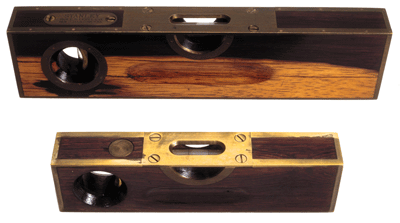American Levels and Their Makers
Stanley Rule & Level Company No. 98 Machinists' Level
 Stanley
began to produce small wooden machinists' levels at about the same time that
they introduced the No. 96. Like the No. 96, the No. 98s were brass bound rosewood
and some of them were of laminated construction. Although they had full brass
end caps from the beginning, the early versions of this level (like the two
shown here) had a nailed on edge binding. Dovetailed bindings would await the
expiration of the Stratton Bros. patents.
Stanley
began to produce small wooden machinists' levels at about the same time that
they introduced the No. 96. Like the No. 96, the No. 98s were brass bound rosewood
and some of them were of laminated construction. Although they had full brass
end caps from the beginning, the early versions of this level (like the two
shown here) had a nailed on edge binding. Dovetailed bindings would await the
expiration of the Stratton Bros. patents.
The two levels pictured here are very short, 9" and 6". But even at this length,
Stanley incorporated the groove along the side. This groove was a patented feature
(June 2, 1891) whose function was to improve the users ability to grip the level
and it was termed the "Hand-y grip." The levels also incorporate three other
new patents (2-23-1892, 2-19-1895, and 6-23-1896). These patents as well as
the one for the "Hand-y Grip" had been awarded to Justus Traut. The first two
dealt with adjustable vials while the 1896 patent concerned vials that could
be reliably marked with black lines to assist the user in determining when the
bubble was centered.
In addition to using ground glass vials, these levels and the No. 96 were the
first to employ brass screws to hold the top plate and end plates. Prior to
this, the levels used iron screws which were susceptible to rust and interacting
with the brass plates they held thereby producing an unsightly black stain.
Iron screws could also disintegrate because of rust creating a problem when
the user tried to replace a damaged vial. Broken screws required that the hole
be abandoned or drilled out, or worse - that the replacement screw would be
crooked and could come through the side of the level.


Copyright 1999 01 Inc., NYC
 Stanley
began to produce small wooden machinists' levels at about the same time that
they introduced the No. 96. Like the No. 96, the No. 98s were brass bound rosewood
and some of them were of laminated construction. Although they had full brass
end caps from the beginning, the early versions of this level (like the two
shown here) had a nailed on edge binding. Dovetailed bindings would await the
expiration of the Stratton Bros. patents.
Stanley
began to produce small wooden machinists' levels at about the same time that
they introduced the No. 96. Like the No. 96, the No. 98s were brass bound rosewood
and some of them were of laminated construction. Although they had full brass
end caps from the beginning, the early versions of this level (like the two
shown here) had a nailed on edge binding. Dovetailed bindings would await the
expiration of the Stratton Bros. patents.